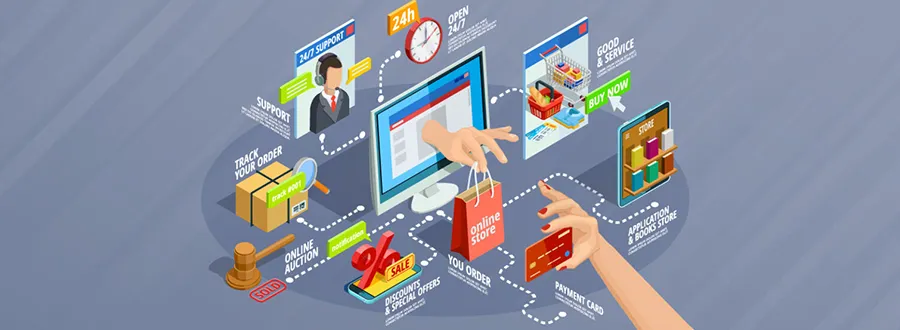Choosing the Right
eCommerce Platform
Why Choosing the Right eCommerce Platform Matters
- Manage inventory efficiently.
- Provide secure payment options.
- Scale your operations as your business grows.
- Optimize for SEO and improve online visibility.
- Enhance user experience to drive conversions and retain customers.
Choosing the wrong platform, however, can lead to inefficiencies, security vulnerabilities, poor customer experiences, and ultimately, lost sales. In a world where online shopping is becoming the norm, having a robust and user-friendly eCommerce platform is essential for success.

Factors to Consider When Choosing an eCommerce Platform
When selecting an eCommerce platform, it’s important to take into account several factors that influence how well the platform will serve your business. Here’s a breakdown of the key elements to keep in mind:
1. Size and Complexity of Your Business
- Small businesses with a limited product catalog and basic functionality needs can opt for user-friendly, all-in-one platforms like Wix or Squarespace. These platforms allow for easy website building, with drag-and-drop editors and no coding required.
- Medium to large businesses that require advanced features, such as multi-currency support, product filtering, customer segmentation, and inventory management, would benefit from platforms like Shopify, BigCommerce, or Magento.
2. Budget and Cost Considerations
- Wix and Squarespace offer low-cost plans that are great for businesses with basic needs but may charge additional fees for advanced eCommerce features like payment gateways and plugins.
- Shopify, while user-friendly and feature-rich, requires a monthly subscription (with various pricing tiers). Plus, it charges transaction fees unless you use Shopify Payments.
- WooCommerce is free to install if you’re already using WordPress, but you may face costs for hosting, themes, and premium plugins.
3. Payment Processors and Payment Flexibility

Payment flexibility is a crucial consideration when choosing an eCommerce platform. A good platform should support
multiple payment gateways, allowing you to offer various methods of payment that customers are comfortable with.
- Shopify integrates seamlessly with Stripe, PayPal, Apple Pay, and other popular payment processors. It’s a great choice for merchants who need quick and easy payment options.
- WooCommerce, being highly customisable, supports a variety of payment gateways, including Stripe, PayPal, and even cryptocurrency options, making it ideal for businesses that need flexibility.
- Wix also integrates with PayPal, Stripe, and other popular processors, though with fewer options for international payment methods than Shopify.
4. Product Categories and Inventory Management
- Shopify offers excellent inventory management features with multi-channel selling options, allowing you to sync your products across various platforms (e.g., eBay, Amazon, social media).
- Magento is designed for large businesses with complex inventory management needs. It supports advanced product cataloguing and allows for extensive customisation of product pages, shipping options, and more.
- WooCommerce, when paired with WordPress, is highly customisable and supports advanced product categorisation and inventory management through plugins like WooCommerce Stock Manager and WooCommerce POS.
5. Scalability and Future Growth
- Shopify is scalable and offers solutions for businesses of all sizes. Its enterprise-level solution-Shopify Plus-is designed for high-volume merchants and provides enhanced features for customisation and security.
- Magento is highly scalable, making it ideal for large businesses with complex requirements. However, the setup and maintenance costs for Magento Enterprise can be significant.
- BigCommerce is also designed for growth. It provides built-in features like multi-currency support, advanced product filtering, and customer segmentation, making it a great choice for businesses expanding their operations.
6. Security and Compliance
Ensuring that your customers’ data is secure is non-negotiable. When selecting an eCommerce platform, you need to ensure it meets PCI compliance standards and follows best practices for data protection.
- Shopify, Magento, and BigCommerce are all PCI DSS compliant and come with SSL certificates to encrypt sensitive data during transactions.
- WooCommerce can be configured for PCI compliance with the right hosting provider and security plugins like Wordfence.
7. Customer Support and Resources
Good customer support is essential for solving problems quickly and preventing downtime. The right platform should offer 24/7 support with multiple support channels, such as live chat, email, and phone.
- Shopify provides round-the-clock support, a comprehensive knowledge base, and a vibrant community forum.
- WooCommerce, being an open-source platform, has a large community and plenty of support options, but you might need to rely on third-party support for some issues.
- Magento offers a premium support package, but its complexity means that troubleshooting may sometimes require specialised knowledge.
Popular eCommerce Platforms: A Detailed Comparison
Shopify

- Best for: Small to medium businesses that need a simple, user-friendly platform.
- Features: Easy-to-use setup, comprehensive theme library, 24/7 support, extensive integrations.
- Pricing: Monthly subscription, transaction fees.
- Pros: Great for beginners, excellent scalability, secure payment processing.
- Cons: Transaction fees if not using Shopify Payments.
WooCommerce
- Best for: Small businesses or users already on WordPress.
- Features: Free plugin, powerful integration with WordPress, large selection of plugins.
- Pricing: Free plugin, but paid hosting, themes, and plugins are required.
- Pros: Highly customisable, no transaction fees, integrates with WordPress.
- Cons: Requires more technical knowledge.
Magento (Open Source)
- Best for: Large businesses with complex needs.
- Features: Robust feature set, advanced product management, powerful marketing tools.
- Pricing: Free (open-source); Magento Commerce (cloud) comes with a price tag.
- Pros: Highly scalable, fully customisable, robust.
- Cons: Complex, requires developer knowledge.
BigCommerce
- Best for: Medium to large businesses.
- Features: Built-in tools for SEO, marketing, and product management.
- Pricing: Monthly subscription.
- Pros: Strong built-in features, scalability.
- Cons: Higher subscription costs than some competitors.

Wix and Squarespace
- Best for: Small businesses and startups.
- Features: Drag-and-drop site builder, basic eCommerce features.
- Pricing: Monthly subscription.
- Pros: Easy setup, great for beginners, stylish templates.
- Cons: Limited scalability for larger businesses.

How to Leverage eCommerce Platforms for Success
Beyond choosing the right platform, optimising your eCommerce store is essential to ensure it performs well in the long term. Here are some additional tips for success:
1. Focus on Mobile Optimisation: As mobile commerce continues to rise, ensure your platform is mobile-friendly and offers a seamless experience on all devices.
2. Invest in SEO: Optimise your product pages, descriptions, and content to ensure high rankings on search engines. Consider integrating SEO plugins or apps.
3. User Experience (UX) : Keep your website easy to navigate, reduce loading times, and implement a smooth checkout process to improve conversion rates.
4. Leverage Marketing Automation: Use platform features or third-party tools to automate email marketing, cart abandonment reminders, and customer re-engagement campaigns.
Zappos - Service as a Differentiator
Zappos built loyalty by treating service and hassle-free returns as core features, not overhead.
What to learn
- Self-serve returns/exchanges with live status.
- Clear SLAs for first response and resolution; publish them.
- Agent enablement: macros, knowledge base, and full order context in the ticketing view.

Amazon - Frictionless Purchase at Scale
Amazon wins on convenience: fast delivery promises, streamlined checkout, and relentless A/B testing.
What to learn
- One-page checkout with wallets (Apple Pay, Google Pay).
- Real-time delivery options and accurate ETAs.
- Continuous testing culture: measure, ship, iterate.

Warby Parker - Reduce Uncertainty to Lift Conversion
Warby Parker blended digital try-on, at-home trials, and straightforward returns to remove buyer doubt.
What to learn
- Fit/size guides, comparison photos, and UGC on PDPs.
- Low-friction trials where unit economics allow.
- Guided selling (quizzes) that route to the right SKUs.

Wayfair - Findability for Huge Catalogues
Wayfair makes millions of SKUs navigable through strong search and structured filters.
What to learn
- Fast, tolerant onsite search (synonyms, “did you mean”).
- Faceted navigation that avoids index bloat (canonicals/noindex where needed).
- Rich attributes powering comparisons and filtered lists.

Boxed - Clear Value for Bulk Buyers
Boxed wins on bulk value, simple delivery, and easy re-orders.
- Transparent bulk/subscription pricing blocks.
- Replenishment prompts based on purchase cadence.
- Cart nudges tied to shipping thresholds (used sparingly).

Conclusion
Selecting the right eCommerce platform is a vital decision that will shape your online business’s success. Whether you go with Shopify for its ease of use, WooCommerce for its flexibility, or Magento for its robustness, make sure you consider your business needs carefully.
At Computing Australia, we specialise in helping businesses find the perfect eCommerce platform that aligns with their goals and technical requirements. Our team has helped many clients launch successful online stores, providing them with strategic insights, custom development, and ongoing support to ensure long-term success.
FAQ
Which platform is best: Shopify, WooCommerce, BigCommerce, or Adobe Commerce?
There is no universal “best”. Choose by requirements: checkout and payments, catalogue complexity, B2B needs, integrations, performance, and TCO. If you need speed and reliability, pick hosted (Shopify/BigCommerce). If you need deep content control and custom logic, WooCommerce or Adobe Commerce.
Do I need a headless setup?
Only if you have complex front-end demands, multi-experience delivery, or strict performance goals a standard theme can’t reach. Otherwise it adds cost and risk with limited ROI.
What features matter most for conversion?
Fast pages (Core Web Vitals), lean checkout with wallets, clear shipping/GST, trust signals, relevant search/filters, strong PDP content, and simple returns. Apps and animations won’t fix slow pages or weak UX.
How should I budget for total cost of ownership (TCO)?
Add licences, payment fees, apps, dev time, hosting (if self-managed), maintenance, data migration, and content. App sprawl is the common blowout—govern extensions and prefer native features.
When should I replatform versus optimise?
Optimise first if the pain is theme, apps, or process. Replatform when core needs (payments, catalogue, B2B, integrations, performance) are blocked by the platform itself despite best-practice optimisation.



